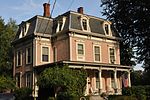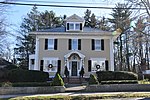Wisteria Lodge (Reading, Massachusetts)
Buildings and structures in Reading, MassachusettsHouses completed in 1850Houses on the National Register of Historic Places in MassachusettsNational Register of Historic Places in Reading, MassachusettsReading, Massachusetts Registered Historic Place stubs ... and 1 more
Second Empire architecture in Massachusetts

Wisteria Lodge is a historic house in Reading, Massachusetts. The 2+1⁄2-story Second Empire wood-frame house was built in 1850 by Oscar Foote, a local real estate developer entrepreneur who attempted to market bottled mineral water from nearby springs. The house has a mansard roof with fish scale slate shingles, bracketed eaves, an elaborate porte cochere, and styled window surrounds with triangular pediments. The porches and porte cochere are supported by square columns set on paneled piers, with arched molding between.The house was listed on the National Register of Historic Places in 1984.
Excerpt from the Wikipedia article Wisteria Lodge (Reading, Massachusetts) (License: CC BY-SA 3.0, Authors, Images).Wisteria Lodge (Reading, Massachusetts)
Summer Avenue,
Geographical coordinates (GPS) Address Nearby Places Show on map
Geographical coordinates (GPS)
| Latitude | Longitude |
|---|---|
| N 42.523625 ° | E -71.118302777778 ° |
Address
Summer Avenue 146
01867
Massachusetts, United States
Open on Google Maps











